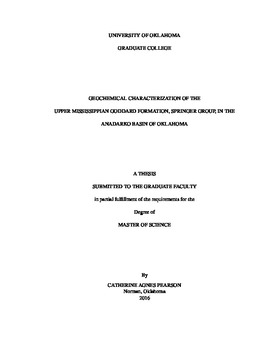| dc.contributor.advisor | Philp, Paul | |
| dc.contributor.author | Pearson, Catherine | |
| dc.date.accessioned | 2016-08-01T15:35:13Z | |
| dc.date.available | 2016-08-01T15:35:13Z | |
| dc.date.issued | 2016 | |
| dc.identifier.uri | https://hdl.handle.net/11244/44596 | |
| dc.description.abstract | The Goddard Formation is the basal unit of the Late Mississippian-Early Pennsylvanian Springer Group of Oklahoma. This Formation is part of a stacked oil and condensate play in the South Central Oklahoma Oil Province (SCOOP). Unconventional production of the Goddard has been ongoing since 2012. However, published geochemical interpretations for this formation are still few. This study characterized regional trends in the organic geochemistry of the Goddard Formation within the Anadarko Basin. Bulk geochemical and biomarker analyses were used to develop an organofacies model for the Goddard. Bulk geochemical and biomarker data were also used to conduct source rocks and oil correlations.
Explanations for an unusual abundance of tricyclic terpanes in this Formation were also evaluated.
This study evaluated 15 source rocks and 11 oils from the Goddard in the Anadarko Basin. An outcrop sample and oil seep from the neighboring Ardmore Basin were also included in the sample set. Analyses were conducted using Rock-Eval pyrolysis, whole oil-gas chromatography, gas chromatography (GC), gas chromatography-mass spectrometry (GCMS), and gas chromatography-mass spectrometry-mass spectrometry (GCMSMS) methods. Geochemical data collected in this study classified the Goddard Formation as a Type B organofacies. This organofacies type reflects a marine depositional environment dominated by siliciclastic sedimentation. Biomarker analyses indicated that the depositional environment for the Goddard was suboxic with normal to slightly elevated salinity and a non-stratified water column. The presence of fusinite and benzo(e)pyrene supported a periodic but minor contribution of oxidized terrestrial plant matter following wildfire events. Comparison of the biomarker signature for both the source rock and oils revealed a striking similarity. The most useful biomarker family for correlation of Goddard source rocks and oils was the tricyclic terpanes.
Tricyclic terpanes dominated the m/z 191 chromatogram for both Goddard oils and extracts. Neither thermal stress nor biodegradation were able to account for the abundance of tricyclic terpanes. Fractionation mechanisms were also inconsistent with the geochemical similarity between the oils and extracts. Finally, the abundance of algae-like Tasmanite fossils, a proposed precursor for tricyclic terpanes, was low in the Goddard. Interpretations in this study support a non-Tasmanite precursor for the tricyclic terpanes. A non-Tasmanite precursor may still have been a marine algae similar to Tasmanite. Glacial production of iron-rich loess and a major mass extinction during the Late Mississippian would have been conducive to blooms of low-diversity algal communities in setting such as the Anadarko Basin.
Future work in the Goddard could include studies of stable carbon isotopes to look for indicators of algal blooms and explore correlation with total organic carbon. Additional biomarker studies could focus on outcrops in the nearby Ardmore Basin to assess whether abundant tricyclic terpanes are only found in the Goddard Formation within the Anadarko Basin. | en_US |
| dc.subject | Goddard Formation | en_US |
| dc.subject | Springer Group | en_US |
| dc.subject | tricyclic terpanes | en_US |
| dc.subject | biomarker | en_US |
| dc.subject | organofacies | en_US |
| dc.title | Geochemical Characterization of the Upper Mississippian Goddard Formation, Springer Group, in the Anadarko Basin of Oklahoma | en_US |
| dc.contributor.committeeMember | Engel, Michael | |
| dc.contributor.committeeMember | Elmore, Douglas | |
| dc.date.manuscript | 2016 | |
| dc.thesis.degree | Master of Science | en_US |
| ou.group | Mewbourne College of Earth and Energy::Conoco Phillips School of Geology and Geophysics | en_US |
